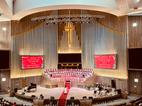Renowned scholar Professor Philip L. Wickeri introduced 26 maps of China drawn by Christians before the 21st century to Chinese scholars.
As an expert in the history of Chinese Christianity, Professor Wickeri gave a lecture titled “Visualizing State and Religion: Christianity and Drawing Maps of China” at the Religion and China Social Research Center at Shanghai University on January 12.
Holding a Ph.D. from Princeton Theological Seminary and serving as an advisor to the Archbishop of Hong Kong on theological and historical studies and provincial archivist of the Hong Kong Sheng Kung Hui Archives, Professor Wickeri was ordained as pastor by the late Bishop K. H. Ting in 1991 and is the author of the book Reconstructing Christianity in China: K.H. Ting and the Chinese Church.
Citing the quote of philosopher Alfred Korzybski, “The map is not the territory,” the speaker first stated that maps were just models to perceive the world rather than present actual reality. However, geography is the key to understanding any religion, according to historian of religion Mircea Eliade. The geography of religion concerns the development and decline of religion.
Professor Wickeri said that geography can be seen as a form of incarnation, as Jesus and his disciples traveled around to preach the gospel to people. Locations such as Jerusalem, Rome, Ephesus, and Antioch can help us learn about the development of Christianity. Meanwhile, Christianity can be called an urban religion, as Pauline epistles and almost half of the New Testament were written particularly for urban Christians.
“Buddhism, Islam, and Christianity are all global religions because their goals are to spread the doctrines of the Buddha, Mohammed, or Jesus over to the ends of the world, so maps have a religious significance, though the initial maps drawn by religious people were very primitive.”
When it came to maps, the professor confessed that mapping is not always a neutral or selfless occupation; it engages with power, territory, and political control. “The same is even more true in Christian maps made by European and North American missionaries.”
Professor Wickeri continued, “While the mapping of Protestant Christianity is not only for the development of the nation, in some cases, it even precedes the development of the nation. It also attempts to document the development of Christianity as a world religion.”
Then Professor Wickeri showed 26 maps by Christians in China, emphasizing the maps drawn by Anglicans and of Hong Kong and Guangdong Province.
He started with a map of China, Korea, and Japan engraved by the Dutch mapmaker Jodocus Hondius based on the accounts of one Portuguese and two Spanish Jesuit missionaries.
A Map of the Myriad Countries of the World, made by Italian Jesuit Matteo Ricci and other missionaries, can be said to be the earliest world map printed in China. Professor Wickeri said there were four editions of this map, and there are just a few copies of the original map in the museum and one private collection.
He introduced that the World Double Hemisphere Map drawn by the Church Missionary Society (CMS) of the Church of England in 1838 aims to “distinguish the stations of Protestant missionary societies and churches” at that time, while the Map of the Basel Mission in Canton was created to “plan the missionary travel routes” in the Hakka region and to train “the prospective missionaries.”
When it came to the Chung Hua Sheng Kung Hui (CHSKH, also known as the Anglican-Episcopal Province of China), there were 13 maps of its dioceses, Anglican churches in Hong Kong, schools, and other organizations, as the speaker illustrated.
As the Diocese of South China was often compared with the Diocese of England, its map (1910-1920) includes Guangdong, Guangxi, Guizhou, and Yunnan. The Map of CHSKH Dioceses, which was completed around 1922, depicts the Anglican diocese of South China at the end of World War II. The Map of the Diocese of Hong Kong drawn in 1937 highlights Hong Kong’s boundary line with other areas, showing the chief parishes and mission stations. The Map of the Chinese Church by CHSKH (around 1941-1942) separated the areas under Japanese occupation from the “Free China” regions when many churches and schools were closed during the difficult time.
Maps of St. James’ Settlement Workshop (1958), the diocese of Hong Kong and Macau's diagram plan of schools and welfare centers (1964), and its diagram plan of churches (1965) were shown as well.
The Macau Church Map serves as a simple tourist map, as “Macau played a crucial role in the history of the spread of the Roman Catholic Church to China through the maritime Silk Road.”
Apart from church and Christian organization maps, Professor Wickeri explained that the Island of Taiwan Map, designed and drawn by the Dutch cartographer Jacob van der Schley in 1764, was supposed to be a means of propaganda to support missionaries there. The Map of Hong Kong, Kowloon, and Adjacent Territories (1910) done by the Ordinance Survey Office in England noted “the precise boundaries of Hong Kong.” The Map of Hong Kong and Canton (1940) demonstrates the two areas’ close geography as “Anglican priests in Hong Kong would go to Canton to conduct Eucharist to relieve the shortage of manpower” during the Anti-Japanese War.
Chinese scholars shared that they felt inspired by the lecture, adding that there could be new approaches to studying the social influence of Christianity in China, such as aerography and fashion.
Professor Han Zhaoqing from the Center for Historical Geographical Studies at Fudan University pointed out that China had a mapmaking tradition. But she expressed regret that the world now uses Western projections and latitude and longitude methods to draw maps. Examining Chinese history, she highlighted the use of tools like rulers and compasses for measurement within a certain distance, but their accuracy diminished for longer distances due to the Earth’s spherical nature. More than 300 years ago, during the Kangxi era, the “Overview Maps of the Imperial Territories” (known in Chinese as Huangyu quanlan tu) was created by Western missionaries who consulted ancient Chinese geographical texts. She lamented that those Chinese traditions were disconnected owing to the absence of a complete education system to nurture Chinese successors and the subsequent Rites Controversy.












